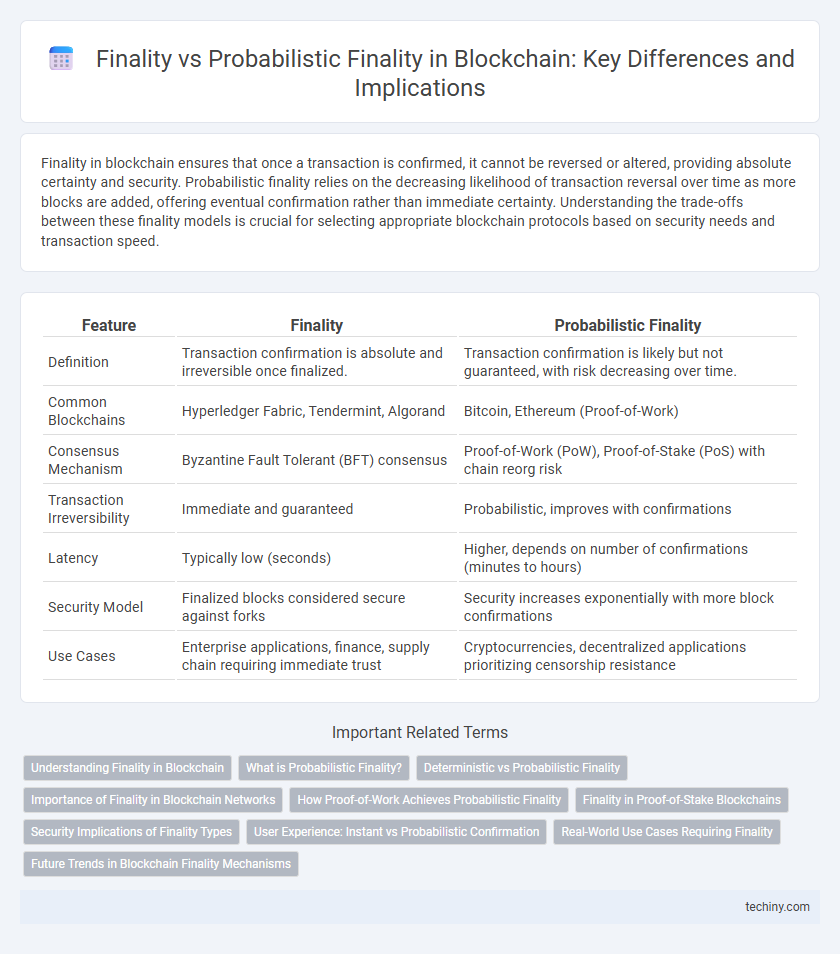Finality in blockchain ensures that once a transaction is confirmed, it cannot be reversed or altered, providing absolute certainty and security. Probabilistic finality relies on the decreasing likelihood of transaction reversal over time as more blocks are added, offering eventual confirmation rather than immediate certainty. Understanding the trade-offs between these finality models is crucial for selecting appropriate blockchain protocols based on security needs and transaction speed.
Table of Comparison
| Feature | Finality | Probabilistic Finality |
|---|---|---|
| Definition | Transaction confirmation is absolute and irreversible once finalized. | Transaction confirmation is likely but not guaranteed, with risk decreasing over time. |
| Common Blockchains | Hyperledger Fabric, Tendermint, Algorand | Bitcoin, Ethereum (Proof-of-Work) |
| Consensus Mechanism | Byzantine Fault Tolerant (BFT) consensus | Proof-of-Work (PoW), Proof-of-Stake (PoS) with chain reorg risk |
| Transaction Irreversibility | Immediate and guaranteed | Probabilistic, improves with confirmations |
| Latency | Typically low (seconds) | Higher, depends on number of confirmations (minutes to hours) |
| Security Model | Finalized blocks considered secure against forks | Security increases exponentially with more block confirmations |
| Use Cases | Enterprise applications, finance, supply chain requiring immediate trust | Cryptocurrencies, decentralized applications prioritizing censorship resistance |
Understanding Finality in Blockchain
Finality in blockchain refers to the point at which a transaction is considered irreversible and permanently recorded on the ledger. Deterministic finality, seen in protocols like Tendermint, guarantees immediate and absolute transaction confirmation, while probabilistic finality, common in proof-of-work systems such as Bitcoin, provides increasing confidence over time as more blocks are added. Understanding these distinctions is crucial for assessing transaction security, network efficiency, and consensus mechanisms in decentralized systems.
What is Probabilistic Finality?
Probabilistic finality refers to the concept in blockchain where transaction confirmation is achieved with increasing certainty over time, rather than an absolute guarantee. Unlike absolute finality, probabilistic finality relies on the likelihood that a block will not be reversed as more blocks are appended, reducing the probability of a fork or double-spend. This mechanism is common in proof-of-work blockchains like Bitcoin, where risk diminishes with each subsequent block added on top of a transaction.
Deterministic vs Probabilistic Finality
Deterministic finality guarantees transaction irreversibility once consensus is reached, eliminating the possibility of forks, as seen in Byzantine Fault Tolerant (BFT) protocols. Probabilistic finality relies on accumulating confirmations, reducing the likelihood of transaction reversal over time, exemplified by Proof-of-Work blockchains like Bitcoin. Understanding the trade-offs between deterministic and probabilistic finality is crucial for applications demanding immediate trust versus those tolerating eventual consistency.
Importance of Finality in Blockchain Networks
Finality in blockchain networks ensures that once a transaction is confirmed, it becomes immutable and irreversible, providing security and trust to participants. Deterministic finality offers immediate and absolute confirmation, crucial for financial applications requiring instant certainty, while probabilistic finality relies on increasing confirmation probabilities over time, balancing scalability and decentralization. Robust finality mechanisms reduce risks of double-spending and blockchain forks, enhancing overall network reliability and user confidence.
How Proof-of-Work Achieves Probabilistic Finality
Proof-of-Work (PoW) achieves probabilistic finality by requiring miners to solve complex cryptographic puzzles, which secures blocks through computational effort and energy expenditure. As new blocks are added on top of a mined block, the probability that the underlying block can be reversed decreases exponentially, ensuring increasing confidence in transaction finality. This mechanism contrasts with deterministic finality by providing high assurance without absolute certainty, relying on the cumulative work embedded in the longest blockchain.
Finality in Proof-of-Stake Blockchains
Finality in Proof-of-Stake blockchains ensures that once a block is confirmed, it becomes an irreversible part of the ledger, preventing forks and double-spending. This deterministic finality contrasts with probabilistic finality in Proof-of-Work systems, where block confirmation probability increases over time but never reaches absolute certainty. Byzantine Fault Tolerant consensus algorithms like Tendermint and Casper deliver immediate finality by requiring a supermajority of validators to agree on the next block before it is appended.
Security Implications of Finality Types
Finality in blockchain determines when a transaction is considered irreversible, directly impacting network security and trust. Deterministic finality ensures transactions are permanently settled once confirmed, minimizing the risk of double-spending and forks. Probabilistic finality, common in proof-of-work systems, reduces the likelihood of transaction reversal over time but requires multiple confirmations to achieve comparable security assurances.
User Experience: Instant vs Probabilistic Confirmation
Instant finality in blockchain ensures users receive immediate confirmation of transactions, enhancing trust and reducing waiting times for transaction settlement. Probabilistic finality relies on multiple confirmations, meaning transaction finality increases over time but initially carries a small risk of reversal, which can cause uncertainty and slower user experience. Optimizing user experience involves balancing instant finality's speed with probabilistic finality's security, especially in applications like payments and decentralized exchanges.
Real-World Use Cases Requiring Finality
Finality in blockchain ensures that transactions are irreversible and universally agreed upon, critical for real-world use cases like financial settlements, cross-border payments, and supply chain verification where error-free validation is mandatory. Probabilistic finality, typical in Proof-of-Work systems, offers eventual consensus but can risk temporary forks, making it less suitable for high-stakes environments requiring immediate certainty. Enterprises in banking and logistics prefer absolute finality protocols like those in Proof-of-Stake blockchains to guarantee transaction integrity and regulatory compliance.
Future Trends in Blockchain Finality Mechanisms
Future trends in blockchain finality mechanisms emphasize the shift towards hybrid models that balance speed and security by combining deterministic finality with probabilistic approaches. Emerging consensus algorithms, such as practical Byzantine fault tolerance (PBFT) variants and proof-of-stake (PoS) protocols, enhance transaction finality while reducing energy consumption and latency. Innovations in layer 2 solutions and interoperability frameworks further drive improvements in achieving scalable, secure, and fast finality across heterogeneous blockchain networks.
finality vs probabilistic finality Infographic

 techiny.com
techiny.com